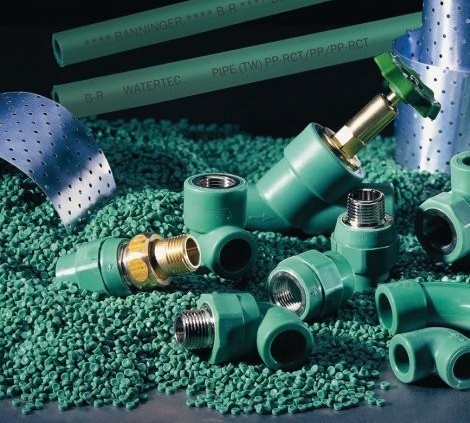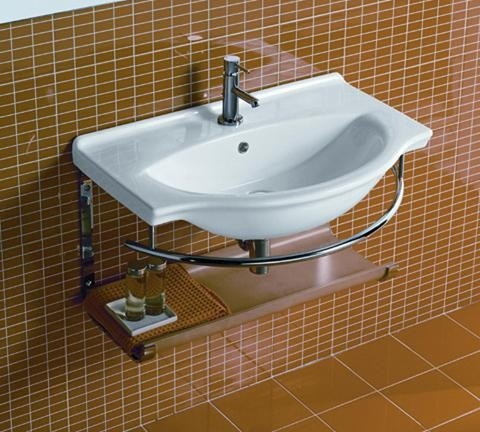Sealants for the bathroom: how to choose the best composition + installation rules
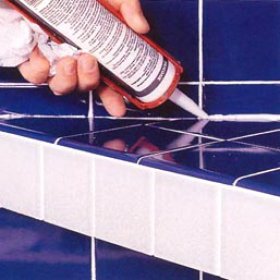
The bathroom has a high level of humidity. It is impossible to deal with this phenomenon. All that can be done is to try to neutralize as much as possible the negative effect of excessive moisture, which is everywhere present in the bathroom. The most vulnerable to moisture areas of the bathroom are all kinds of joints. This is where moisture builds up. It gradually penetrates deep into unprotected materials, destroying them, and becomes a breeding ground for the growth of dangerous microorganisms. That is why joints need special protection. Traditionally, special cement grouts were used for these purposes. Now, experts recommend laying a sealant for the bathroom, a special sealing material.
Content
Types of sealants and their features
Sealants are a very large group of chemical compounds. They are designed to protect various joints, joints, etc. from moisture. Insulating materials are all kinds of compositions made of polymers with a variety of modifying additives. What sealants are intended for a bathroom read below.
Option # 1 - Silicone Compounds
This composition is used in the bathroom most often. The sealant is based on silicone, which gives it excellent water-repellent properties. In addition, the material has a long service life and good adhesion to surfaces of various types. The industry produces two types of silicone compounds:
- Acidic, it can also be called vinegar. The price of such material is relatively low. However, a restricted composition is used. Due to the presence of acid during the vulcanization process, the substance promotes the oxidation of metals. Therefore, in the case of sealing metal surfaces, the acid composition can be applied only to stainless steel.
- Neutral, in which there is no acid. Sealing material is more expensive than an acid analogue, but is devoid of its disadvantages. It is used for all surfaces without any restrictions. Especially good for acrylic bathtubs.
The composition can be used in the temperature range from +200 to -50 ° C, it tolerates even sharp temperature changes.
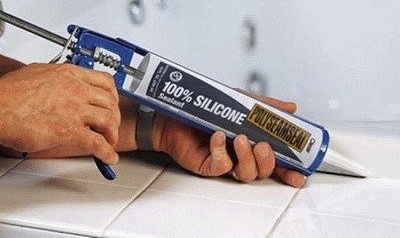
Silicone sealants are characterized by excellent water resistance, ease of use, durability and good adhesion to the base. However, remember that acid formulations may not be used on all surfaces.
Option # 2 - Acrylic Sealants
Practical and very inexpensive sealants. They are characterized by high adhesion to almost all types of materials, including porous. The composition of the coating does not include organic solvents, which guarantees the absence of an unpleasant odor and allows you to work with acrylic compositions without special protective equipment. Full curing of the agent occurs only after a day.
Moisture-resistant and moisture-resistant sealant variations are available. The second, for obvious reasons, can not be used in the bathroom. The main disadvantage of acrylic sealants of all types is the low elasticity of the formed coatings. Therefore, the material is used only for areas that will not be subjected to deformation.
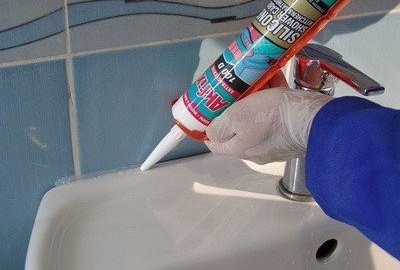
Acrylic sealants are non-toxic and are characterized by high moisture resistance. However, they are not elastic, which limits the scope of their application to surfaces that will not undergo deformation.
Option # 3 - Silicone-Acrylic Sealants
The composition of the material includes both silicone and acrylic. This combination allows you to get the composition, devoid of the disadvantages of silicone and acrylic analogues, while retaining all their advantages.
The insulating coating is characterized by strength, durability, moisture resistance and high elasticity. It can be used as adhesive sealant. In this case, the composition connects two surfaces and simultaneously seals them.
Option # 4 - polyurethane compounds
The basis for the material is polyurethane. The polymerization of the product begins when it comes into contact with air, due to the moisture contained in it. The material is easy to use, economical, maintainable and durable. The composition is characterized by low shrinkage, good adhesion to all types of coatings, elasticity and strength. Under the influence of moisture, the material becomes even stronger, not afraid of mechanical damage.
Feature coating - quick setting and hardening. This must be considered when applying it. Open packaging should be used immediately, otherwise the composition will polymerize directly in it. When working with polyurethane sealant gloves must be worn to protect the skin of the hands. The composition can be used for gluing small fragments and for repairing cracks. After drying, the sealant can be painted or varnished.
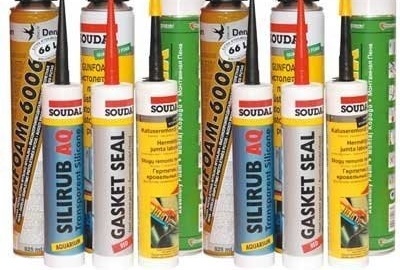
The range of sealants is very wide. When choosing a product for your bathroom, you should pay attention to sanitary solutions, which not only protect the surface from moisture, but also contain substances that limit the growth and development of microorganisms
The main types of sealants used for bathrooms are listed above. Other types of compositions, such as thiokol, bitumen and other sealants, are most often not used here. There are a number of materials that the manufacturer positions as sanitary sealants. These can be compositions of various types. Their main difference is the presence of special additives: antiseptics and fungicides that prevent the appearance and development of harmful microorganisms.
How to choose the composition you need?
When choosing a sealing compound for your bathroom, several important points to consider:
- The purpose of the sealant. On sale you can find professional and household materials. The former are most likely more difficult to apply.
- Moisture resistance. This indicator must be indicated on the package. It is necessary to select the optimal values for their conditions.
- Coating, which is supposed to + apply the composition. Make sure that the selected sealant can be used on the surface for which it is intended.
- The amount of impurities. An indicator especially relevant for silicone formulations. In this case, the mass fraction of impurities of more than 10% indicates a decrease in operational characteristics, in particular, a decrease in elasticity.
In addition, look at the color of the material.Transparent, white and color sealants are available - which one will suit your design, only you know.
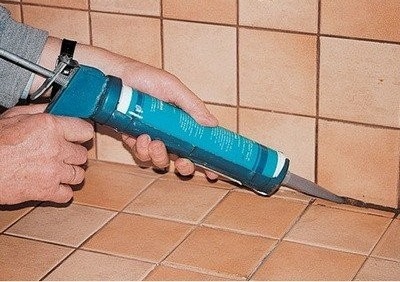
In some cases, it becomes necessary to use a colored sealant that is suitable in tone to the tiles. Such formulations can be found in hardware stores.
How to properly seal
There are no difficulties in applying the composition. It is important to familiarize yourself with the manufacturer's instructions and clearly follow them before starting work. In general, the sealant is applied as follows:
- Cooking surface. To do this, thoroughly clean it from pollution, remove bumps, wash it and wipe it dry.
- For better adhesion of the sealant to the base, we degrease it. To do this, wipe the prepared surface with acetone or alcohol and dry thoroughly.
- Cooking sealant. We cut off the corner on the tube with the composition at an angle of 45 °, which will enable the composition to lie on the base in the way we need. We wrap a special cap on the tube, closing the sealant, and insert it into the mounting gun.
- We apply the composition. Using a mounting gun, we distribute the sealant on the surface. You need to control the force of pressing and speed to get an even seam. If it turned out uneven, level it with a spatula dipped in water.
- If necessary, remove excess composition by wiping it with a rag dampened in gasoline or solvent.
Usually, the sealant stops sticking after half an hour. However, for complete drying it will most likely take about a day. At this time, it is best to carry out work not related to the surface treated with the composition.
How to remove an old sealing compound
If applying sealant is simple, then removing it is a more difficult task. There are two ways to solve it.
Mechanical cleaning of the base
For work you will need a razor blade or a stationery knife. It is possible to use a very sharp kitchen knife. The method consists in layer-by-layer cutting of the composition from the base. The cutting surface is applied to the coating and carefully cut. Despite the apparent simplicity of the operation, it should be carried out with extreme caution, without haste.
An attempt to roughly tear off the sealant will result in the loss of pieces of the base that will be torn out with the coating. Do not press hard on the cutting surface, either, since the surface of the bath can be easily damaged. It is very good to use a brush that is useful for sweeping scraps. After the procedure, the remains of the sealant are removed using a hard metal washcloth or any abrasive.

Mechanical cleaning of the surface from the old sealant is a laborious undertaking. It is important to perform the operation very carefully, otherwise the base can be easily damaged.
Chemical removal
Mechanical cleaning is a very laborious undertaking. To facilitate complex work, you can use special chemical detergents to soften the sealant. A large number of such solutions are available for various types of sealing compounds. The cleaner may be a liquid, paste, or aerosol. To dissolve silicone sealants, you can try to apply white spirit as a wash. It will turn silicone into slurry.
It is worth choosing the type of application that will be most convenient in a particular case. The solution is applied directly to the sealant. After which it must be left for some time necessary to complete the chemical reaction.
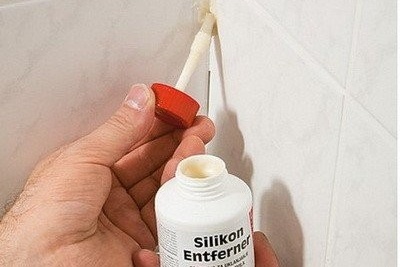
Sealer Wash - a toxic chemical solution. It actively dissolves the sealant, turning it into an easily removable slurry. When working with the composition, one should not forget about measures to protect the skin and respiratory system
Dissolved material is removed with a napkin or rags. If necessary, the procedure can be repeated.Experts recommend applying a small amount of the drug to the surface and looking at the result before starting chemical cleaning. This is necessary because some compounds can damage decorative surfaces. When working with active chemicals, precautions should not be forgotten. Respiratory organs must be protected with a respirator, hands with gloves, and ventilation should be established in the room.
The range of various sealants for bathrooms is very wide. It is difficult to unequivocally answer which one is the best. Each composition is designed to solve certain problems. Therefore, it is very important to choose the right tool. It should be as suitable as possible for certain conditions. This is easy enough to do. You just need to carefully study the information on the package of your favorite composition. If you still have difficulties, you can turn to a sales assistant for help, who should know the assortment of sealants well. Properly selected and applied material will reliably protect joints and seams in the bathroom.

